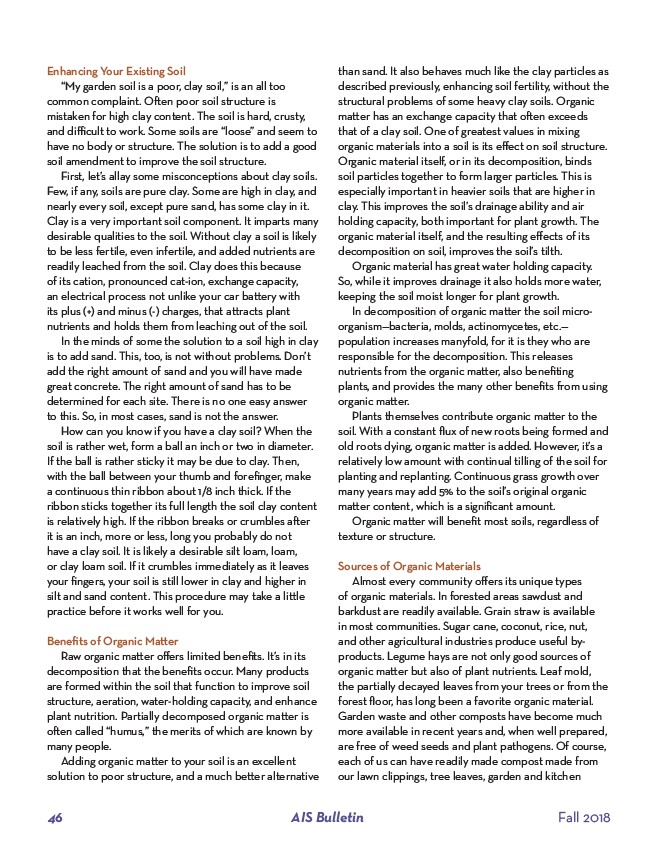
Enhancing Your Existing Soil
“My garden soil is a poor, clay soil,” is an all too
common complaint. Often poor soil structure is
mistaken for high clay content. The soil is hard, crusty,
and difficult to work. Some soils are “loose” and seem to
have no body or structure. The solution is to add a good
soil amendment to improve the soil structure.
First, let’s allay some misconceptions about clay soils.
Few, if any, soils are pure clay. Some are high in clay, and
nearly every soil, except pure sand, has some clay in it.
Clay is a very important soil component. It imparts many
desirable qualities to the soil. Without clay a soil is likely
to be less fertile, even infertile, and added nutrients are
readily leached from the soil. Clay does this because
of its cation, pronounced cat-ion, exchange capacity,
an electrical process not unlike your car battery with
its plus (+) and minus (-) charges, that attracts plant
nutrients and holds them from leaching out of the soil.
In the minds of some the solution to a soil high in clay
is to add sand. This, too, is not without problems. Don’t
add the right amount of sand and you will have made
great concrete. The right amount of sand has to be
determined for each site. There is no one easy answer
to this. So, in most cases, sand is not the answer.
How can you know if you have a clay soil? When the
soil is rather wet, form a ball an inch or two in diameter.
If the ball is rather sticky it may be due to clay. Then,
with the ball between your thumb and forefinger, make
a continuous thin ribbon about 1/8 inch thick. If the
ribbon sticks together its full length the soil clay content
is relatively high. If the ribbon breaks or crumbles after
it is an inch, more or less, long you probably do not
have a clay soil. It is likely a desirable silt loam, loam,
or clay loam soil. If it crumbles immediately as it leaves
your fingers, your soil is still lower in clay and higher in
silt and sand content. This procedure may take a little
practice before it works well for you.
Benefits of Organic Matter
Raw organic matter offers limited benefits. It’s in its
decomposition that the benefits occur. Many products
are formed within the soil that function to improve soil
structure, aeration, water-holding capacity, and enhance
plant nutrition. Partially decomposed organic matter is
often called “humus,” the merits of which are known by
many people.
Adding organic matter to your soil is an excellent
solution to poor structure, and a much better alternative
than sand. It also behaves much like the clay particles as
described previously, enhancing soil fertility, without the
structural problems of some heavy clay soils. Organic
matter has an exchange capacity that often exceeds
that of a clay soil. One of greatest values in mixing
organic materials into a soil is its effect on soil structure.
Organic material itself, or in its decomposition, binds
soil particles together to form larger particles. This is
especially important in heavier soils that are higher in
clay. This improves the soil’s drainage ability and air
holding capacity, both important for plant growth. The
organic material itself, and the resulting effects of its
decomposition on soil, improves the soil’s tilth.
Organic material has great water holding capacity.
So, while it improves drainage it also holds more water,
keeping the soil moist longer for plant growth.
In decomposition of organic matter the soil micro-organism—
bacteria, molds, actinomycetes, etc.—
population increases manyfold, for it is they who are
responsible for the decomposition. This releases
nutrients from the organic matter, also benefiting
plants, and provides the many other benefits from using
organic matter.
Plants themselves contribute organic matter to the
soil. With a constant flux of new roots being formed and
old roots dying, organic matter is added. However, it’s a
relatively low amount with continual tilling of the soil for
planting and replanting. Continuous grass growth over
many years may add 5% to the soil’s original organic
matter content, which is a significant amount.
Organic matter will benefit most soils, regardless of
texture or structure.
Sources of Organic Materials
Almost every community offers its unique types
of organic materials. In forested areas sawdust and
barkdust are readily available. Grain straw is available
in most communities. Sugar cane, coconut, rice, nut,
and other agricultural industries produce useful by-products.
Legume hays are not only good sources of
organic matter but also of plant nutrients. Leaf mold,
the partially decayed leaves from your trees or from the
forest floor, has long been a favorite organic material.
Garden waste and other composts have become much
more available in recent years and, when well prepared,
are free of weed seeds and plant pathogens. Of course,
each of us can have readily made compost made from
our lawn clippings, tree leaves, garden and kitchen
46 AIS Bulletin Fall 2018